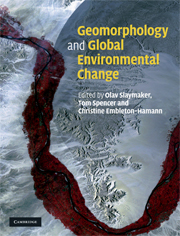Book contents
- Frontmatter
- Contents
- List of contributors
- Preface
- Acknowledgements
- List of acronyms and abbreviations
- 1 Landscape and landscape-scale processes as the unfilled niche in the global environmental change debate: an introduction
- 2 Mountains
- 3 Lakes and lake catchments
- 4 Rivers
- 5 Estuaries, coastal marshes, tidal flats and coastal dunes
- 6 Beaches, cliffs and deltas
- 7 Coral reefs
- 8 Tropical rainforests
- 9 Tropical savannas
- 10 Deserts
- 11 Mediterranean landscapes
- 12 Temperate forests and rangelands
- 13 Tundra and permafrost-dominated taiga
- 14 Ice sheets and ice caps
- 15 Landscape, landscape-scale processes and global environmental change: synthesis and new agendas for the twenty-first century
- Index
3 - Lakes and lake catchments
Published online by Cambridge University Press: 05 July 2015
- Frontmatter
- Contents
- List of contributors
- Preface
- Acknowledgements
- List of acronyms and abbreviations
- 1 Landscape and landscape-scale processes as the unfilled niche in the global environmental change debate: an introduction
- 2 Mountains
- 3 Lakes and lake catchments
- 4 Rivers
- 5 Estuaries, coastal marshes, tidal flats and coastal dunes
- 6 Beaches, cliffs and deltas
- 7 Coral reefs
- 8 Tropical rainforests
- 9 Tropical savannas
- 10 Deserts
- 11 Mediterranean landscapes
- 12 Temperate forests and rangelands
- 13 Tundra and permafrost-dominated taiga
- 14 Ice sheets and ice caps
- 15 Landscape, landscape-scale processes and global environmental change: synthesis and new agendas for the twenty-first century
- Index
Summary
Introduction
Wetlands (including rivers – see Chapter 4 – and coastal wetlands – see Chapter 5), lakes and reservoirs are distinct elements of the hydrological cycle from the atmosphere to the ocean. In this chapter, the focus is on lakes and lake catchments but certain aspects of wetlands and reservoirs require comment. Saline lakes, such as the Caspian, Aral and Dead seas, also come under the purview of this chapter. Lakes, reservoirs and freshwater wetlands vary spatially as a function of relief, climate and human activity and respond variably over time to changes in hydroclimate and human activity. They act as integrators of processes that are taking place in their tributary catchments and are sensitive indicators of environmental change. At the smallest scales (less than 0.01 km2) lakes merge with wetlands, which are among the most ephemeral landscape elements (Table 3.1).
Wetlands represent the ecotone between terrestrial and aquatic environments. They occur in depressions in the landscape where the groundwater table intersects the surface for much or all of the year. Wetlands are variously classified as bogs (acidic peat lands maintained by incoming precipitation), fens (peat lands receiving groundwater drainage), marshes (seasonally or perennially flooded land with emergent herbaceous vegetation), swamps (wooded marshes), saline wetlands (pans or playas), permanent rivers (see also Chapter 4) and open water (characteristically less than 2 m deep). Wetlands are perennially or seasonally saturated or flooded ground. Seasonal wetlands are saturated for sufficient time to support vegetation that thrives under saturated conditions. Freshwater wetlands are of major hydrological importance, for they store substantial volumes of terrestrial runoff and are therefore an important flood-mitigating factor. Conversely, they contribute water to the downstream drainage basin far into the dry season and so are a significant source of base flow maintenance. Freshwater wetlands also accumulate biomass which has its own stratigraphy and provides a number of proxies for past environmental conditions.
- Type
- Chapter
- Information
- Geomorphology and Global Environmental Change , pp. 71 - 97Publisher: Cambridge University PressPrint publication year: 2009



